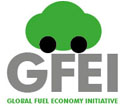
Penalties
Penalties are put in place to assess fines on vehicle manufacturers for failure to meet fuel economy/consumption standards.
For example, in the US manufactures whose fleets fail to meet CAFE standards are liable for a civil penalty of $5.50 per each tenth of a mpg under the target value times the total volume of vehicles manufactured for a given model year. From 1983 to 2004, manufacturers paid more than $618 million in civil penalties. Manufacturers pay a penalty calculated to the falloff in miles per gallon times the total volume of those vehicles made in a given model year.
Most European manufacturers regularly pay CAFE civil penalties ranging from less than $1 million to more than $27 million annually.
European Union
Compliance with EC targets will likely be assessed at European Community level. Manufacturers whose average specific emissions of CO2 exceed those permitted under the planned Regulation would pay an excess emissions premium in respect of each calendar year from 2012 onwards. The premium would be adjusted according to the extent to which manufacturers fail to comply with their target and would likely increase over time. In order to provide a sufficient incentive to take measures to reduce specific emissions of CO2 from passenger cars, the premium would likely reflect technological costs. The amounts of the excess emissions premium would then be considered as revenue for the general budget of the European Union.
If the average CO2 emissions of a manufacturer's fleet exceed its limit value in any year from 2012, the manufacturer would have to pay an excess emissions premium for each car registered. This premium amounts to €5 for the first g/km of excess, €15 for the second g/km, €25 for the third g/km, and €95 for each subsequent g/km. From 2019, already the first g/km of excess will cost €95.
Japan
For automobiles, fuel efficiency standards using the ‘Top Runner’ efficiency program were introduced in 1999 to promote energy savings and reduce CO2 emissions.
Fuel economy targets are based on weight class, with automakers allowed to accumulate credits in one weight class for use in another, subject to certain limitations. Penalties apply if the targets are not met, but they are minimal.
The effectiveness of the standards is enhanced by highly progressive taxes levied on the gross vehicle weight and engine displacement of automobiles when purchased and registered. These financial incentives promote the purchase of lighter vehicles with smaller engines. For example, the Japan Automobile Manufacturers Association (JAMA) estimates that the owner of a subcompact car (750 kg curb weight) will pay $4,000 less in taxes relative to a heavier passenger car (1,100 kg curb weight) over the lifetime of the vehicle (JAMA 2007). Penalties are essentially transposed onto the consumer.
China
China also has put in place a tax structure that penalizes large-engine cars and encourages the purchase of fuel efficient cars. The schedule for this tax structure is shown below Category by engine displacement (L) Tax rate prior to 4/1/2006 (%) Tax rate 4/1/2006-8/31/2008 (%) Tax rate beginning 9/1/2008 (%)
Category by engine displacement (L) |
Tax rate prior to 4/1/2006 (%) |
Tax rate 4/1/2006-8/31/2008 (%) |
Tax rate beginning 9/1/2008 (%) |
<1.0 |
3 |
3 |
1 |
1.0-1.5 |
5 |
3 |
3 |
1.5-2.0 |
5 |
5 |
5 |
2.0-2.5 |
8 |
9 |
9 |
2.5-3.0 |
8 |
12 |
12 |
3.0-4.0 |
8 |
15 |
25 |
4.0 and greater |
8 |
20 |
40 |







